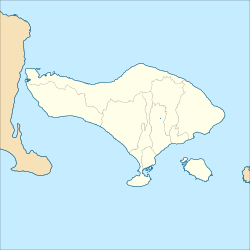The failure of the “Green Revolution”
Indonesia had to import yearly almost a million tons of rice during the 1950s. The “Green Revolution”, promising higher yields in rice, was therefore very well received: in 1967 the government launched the Bimbingan massal (BIMAS), or “massive guidance” program, which reached Bali in 1971. Farmers were provided with high-yielding rice seeds and easy access to fertilizers and pesticides, and encouraged to grow three crops a year since the new rice varieties grew faster than the native crops. [12] Legal penalties compelled farmers to plant the new rice seeds that demanded year-round irrigation. Three years later, in 1974, started the reports of “chaos in water scheduling” and “explosions of rice pests.” Still, the “Green Revolution rice” covered 70% of the rice terraces in South Bali by 1977 and the Asian Development Bank began at about the same time a major irrigation development project in Bali, while promoting the use of pesticides rather than synchronizing fallow periods to control pests. [12] This led to up to 50% of crop losses due to pests in the late 1970s, when subaks planted rice continuously and cropping patterns were very disorganized. In 1988, a study by World Bank officials reported that the use of pesticides had “pervasively polluted the island's soil and water resources.” [12] That same year the Indonesian government at last recognized the crisis and refused to follow the World Bank directives any further; Suharto revoked his own government's directives, the subak system regained its power of decision over the agriculture, farmers went back to coordinated planting and crops began to recover.
Present threats
The subak system is presently challenged by a number of factors, including: the small size of individual properties that limits the farmers' ability to attain a decent living; the ageing of subak members, with an age average over 40 years-old in 2019; the decreasing quantity of water resources and pollution; the heavy financial burden on the farmers for carrying out subak activities; and the national government promulgating unclear regulations concerning the irrigation, including traditional irrigations. Since about 2010, farmers can be exempted from the payment of rice taxes and may be assisted with crop insurance, in a bid to encourage the continuation of rice plantations. Since 2018, prajuru that are grouped in a sustainable subak scheme receive monthly incentives of Rp. 1,500,000 (about US$100) for the pekaseh and Rp. 650,000 (approximately US$40) for the petajuh / pangliman, to help them work diligently in managing the various needs and problems faced by subaks. Farming equipment such as tractors and subsidies for fertilizers, seeds, and pesticides required by subak are facilitated through the Joint Farmers Groups (gapoktan) or Service Facilities Units (UPS) established by the prajuru and the krama subak.
- Loss of land
The highest threat concerns the rice fields that are closest to areas undergoing fast development in such sectors as commercial, housing, industry and other infrastructure development. The land has become a commodity and a subject of speculation. The subak near Denpasar are particularly affected: in 1993 their surfaces totaled 5,753.43 hectares (14,217.0 acres); in 2006 there remained only 2,717 hectares (6,710 acres) - this last figure was maintained up until 2014, with 935 hectares (2,310 acres) in South Denpasar, 726 hectares (1,790 acres) in East Denpasar, 284 hectares (700 acres) in West Denpasar and 772 hectares (1,910 acres) in North Denpasar. But by 2018 nearly 300 hectares (740 acres) were lost again, down to 2,444 hectares (6,040 acres). An average of 20 to 30 ha of agricultural land is lost each year in that area, and around 1,000 hectares (2,500 acres) / year in the whole of Bali. Beyond the agricultural necessity, landscape and culture negatively affected by uncontrolled tourism are heading fast towards a situation where “tourism kills tourism”.
In the case of Denpasar, the local government is working on the city to be listed as a Heritage City (Kota Pusaka) and the maintenance of the local subak system is part of that effort. The status of Heritage City would drastically reduce the conversion of rice fields into other land uses and would be a considerable help in maintaining the remaining subak. The prajuru have also started introducing a new regulation that prohibits changing the use of the land following a sale.
- Water diverted to tourism and polluted
Water pollution and freshwater scarcity have also become major threats, and not just to the subak. Water is diverted from agriculture to tourism and the mass tourism industry has become the largest consumer of water, consuming 65% of freshwater in Bali and having lowered the island's water table by some 60%. Water supplies have reached a critical stage, with water shortage “directly linked to loss of cultivated land.” It is not only a matter of quantity but also of quality: lower water table means that salt water is due to fill that gap because of the constant enormous pressure from the ocean onto the land. This is already happening: as of 2020, some people in Denpasar have had to leave their ancestral home because their well's water has become salty. An article from December 2019 signals that this diversion of water to urban areas and overuse of groundwater by hotels is disrupting the subak's water system.









